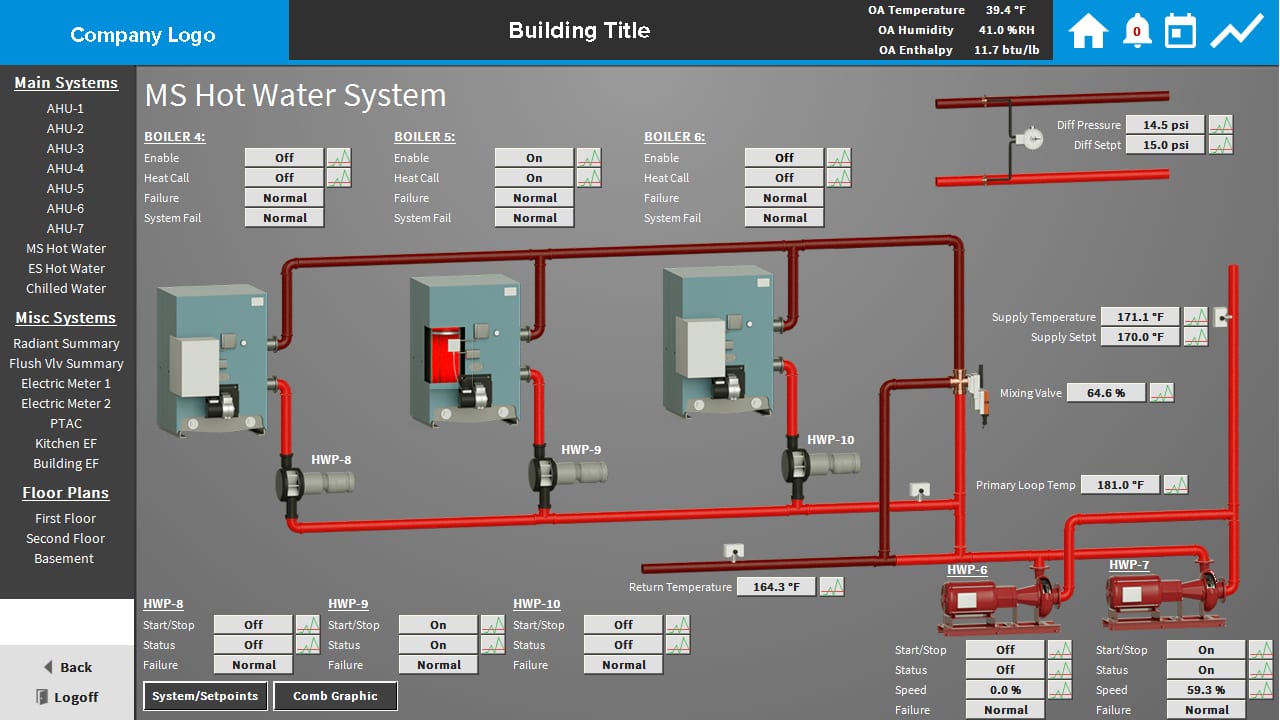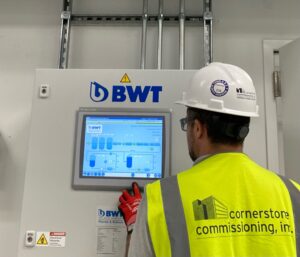The BAS & the Commissioning Provider
As Building Automation Systems were evolving and becoming common place, a new discipline referred to as Commissioning was emerging in the HVAC industry. Commissioning is the process of verifying that a building’s mechanical, electrical, and plumbing (MEP) systems perform correctly and efficiently, per the design intent and owner’s project requirements. In most commercial facilities, these MEP systems are controlled and monitored by a BAS. A well-designed BAS operates in a networked fashion to schedule equipment run times, control equipment per a sequence of operation, and provide the building operator with real-time and historical data, including alarm notifications. The BAS platforms of today function as the “brain” of the building, maintaining occupant comfort and optimizing energy efficiencies. As such, the Commissioning Provider (CxP) is tasked with the role of operating the BAS to test and document how the MEP systems are performing. This sounds straightforward, right?
Essential CxP Competencies
Today’s CxP must possess a broad spectrum of knowledge encompassing many disciplines. At the forefront of this knowledge lies the task of understanding the BAS and how to operate it to test MEP systems. As though this isn’t challenging enough, the CxP must possess the skills to operate a variety of BAS platforms produced by multiple manufacturers. Though there are many common factors among BAS platforms, each manufacturer has definable and distinct differences. Largely, these differences are seen and experienced at the User interface level. Most BAS platforms utilize graphic-based navigation to control and monitor MEP equipment. Understanding how to navigate within the graphics, adjust schedules and setpoints, and execute operator commands is beneficial when commissioning. While some commissioning providers rely on the controls contractor to perform these tasks, Cornerstone prefers to take more of a direct approach, operating the BAS and testing MEP systems independent of the controls contractor.
In addition to a comprehensive knowledge of the BAS, it is essential that the CxP have a full understanding of the equipment being controlled. This is particularly true for occupied buildings. The CxP may be testing only the central heating water plant, but meanwhile heating capacities in AHUs and VAV boxes throughout the building are subject to temperature fluctuations during testing. If the CxP has questions – answers need to be pursued. Peers, the controls technician, and others should be consulted as necessary to gain the understanding and confidence required to properly commission a facility.

The BAS & Project Site Obstacles
Even for the most skilled CxP, realities on the project site can make or break the commissioning process. Inevitably the CxP must first conquer “the connection”. It may seem simple but acquiring the method of connection to the BAS and the credentials required for access can be cumbersome. Early planning and consistent communication are usually the best recipe for success. Coordination with the controls contractor and other project team members is needed to determine how the CxP will connect to the BAS. Alternative methods of connection, such as Wi-Fi or a local ethernet connection must be implemented to gain access to the BAS. Parallel to this process, the CxP needs to ensure that the user credentials provided allow for full control functions needed during testing. This includes the ability to issue operator adjustments, commands, and overrides, etc. Restricted credentials that limit the CxP to monitoring only type functions simply do not work. Additionally, the BAS must be programmed, and the user interface configured in a manner that facilitates access to all applicable points needed to fully test the sequence of operation. In some instances, various portions of the test script will necessitate the need to have the controls contractor assist with testing. Developing and maintaining a good working relationship with key individuals on site is the best roadmap for successful testing of any BAS.

The BAS & Final Outcomes
There are “best practices” when it comes to operating the BAS to commission a building. It’s always a good idea to capture as-found screen shots of any system prior to testing. This serves a couple purposes, but primarily it confirms current operating conditions and setpoints prior to any functional testing by the CxP. When testing it is commonplace to change setpoints and place points in either an override or out-of-service state. Take good notes to record all points that were changed so they can be adjusted back to pre-test values when testing is completed. Some BAS platforms allow the user to perform timed overrides. This type of override will release back to its previous value at the end of a fixed or customized time. If the BAS has this feature, use it! At the end of the day, there is no need to question if all overrides were released prior to leaving the site. Some systems offer queries to search for points in override or placed out-of-service. This is also a great tool for the CxP to ensure that the BAS was left as found. At the conclusion of testing, capturing an as-left screen shot also provides a level of assurance that systems have been returned to their normal operating state.
The BAS should be an asset to the facility and its occupants. Commissioning, done right, provides the level of assurance necessary to achieve this outcome for building owners and occupants.





